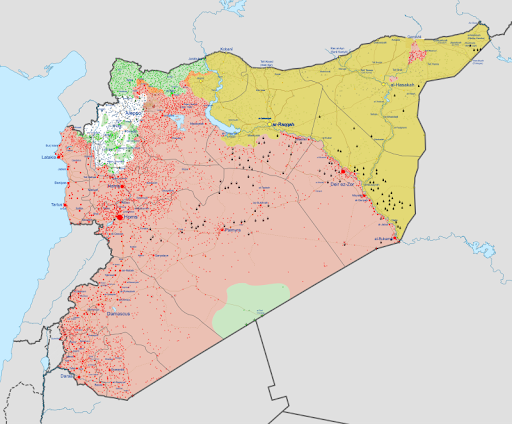The Consequences of a U.S. Withdraw From Syria

Photo Courtesy of User Ermanarich of Wikipedia.
On 19 December 2018, President Donald Trump declared on Twitter that the U.S. military would withdraw from Syria, apparently without warning other member nations of the Defeat ISIS coalition, and against the advice of most of his administration. If a withdrawal does occur unimpeded within the next several months, then a power vacuum will likely be opened in northeastern Syria, allowing other regional actors such as the Assad government, Turkey, or Iran to fill the void.
Currently, US forces are stationed in two main areas. The first is the region controlled by the Syrian Democratic Forces (SDF), an umbrella group of several militias (in yellow on the map). The largest and most prominent of these are the YPG and YPJ, both ethnically-Kurdish groups. Smaller SDF-aligned groups include defector organizations from the now-defunct Free Syrian Army, the Syriac Military Council (composed of Christian Assyrian people), various Arab tribal militias, and the International Freedom Battalion (composed of communist and anarchist volunteers from Turkey, Greece, Europe, and North America). The US began supporting the SDF, and has since supplied trucks, weapons, ammunition, and equipment to these forces as well as provided airstrike support. The US has also constructed several bases in the region, hosting marines and several special operations units. The official mission of US forces in Syria, to defeat ISIS, was completed in early February 2019, when their last village, Baghuz al-Fawqani, was taken by SDF forces.
The situation is complicated with the presence of Turkey, to the north of Syria. Turkey, a NATO ally of the US, sees the SDF as a threat to its own internal security, due to its links to the PKK. The PKK, like the YPG (the largest SDF component) is a Kurdish organization, however, it fights against Turkey, and is therefore considered a terrorist group. Should the US withdraw from Syria, Turkey will likely use the lack of US forces to invade SDF territory and incorporate it into the area it already holds in Syria (dark green in the northwestern section of the map). This would be problematic for the Kurds living there because Turkey has announced its intentions to move Syrian refugees (mostly Arabs) into the land it controls (mostly Kurdish), therefore creating a demographic shift in the region. The Kurds would eventually become a minority in their area and begin to lose their culture.
Another threat to the SDF comes from within Syria. The Assad government (red on the map) has not come into open conflict with the SDF yet, but has very stated that they will “recover every inch of Syria.” This would likely occur with a voluntary SDF surrender rather than war, however. Without the US, the SDF has no chance of being able to succeed against Assad and his allies, Russia and Iran. The war may drag on, but Assad would still win in the end. Because of this, the SDF has been involved in secret negotiations with Assad. The likeliest outcome of this would be the SDF’s integration into the Syrian army and loss of sovereignty, in exchange for protection against Turkey, who is a threat to both parties, and cultural concessions (freedom to use the Kurdish language in education and media).
The second region where the US has a base is al-Tanf, a tiny village in the Syrian desert (light green area in southeast of the map). Here, the US supports the Maghawir al-Thawra (MaT) rebel group, a very small Arab rebel group composed of about 300 people. Strategically, the area is almost worthless, it is large, but entirely desert. The US maintains its base here because a road runs from Iran, through Baghdad, and through this desert to Damascus. If controlled by the Assad government, Iranian military support could easily arrive overland. Currently, they must use a less-convenient road through al-Bukamal instead. A US withdrawal would certainly compel Assad to retake these lands.
In conclusion, the withdrawal of US forces from Syria has the possibility to destabilize a region that is just starting to find its feet again after eight years of brutal war. Our allies are left open to domination by Turkey or Assad, and the influence of Russia and Iran can only grow.



